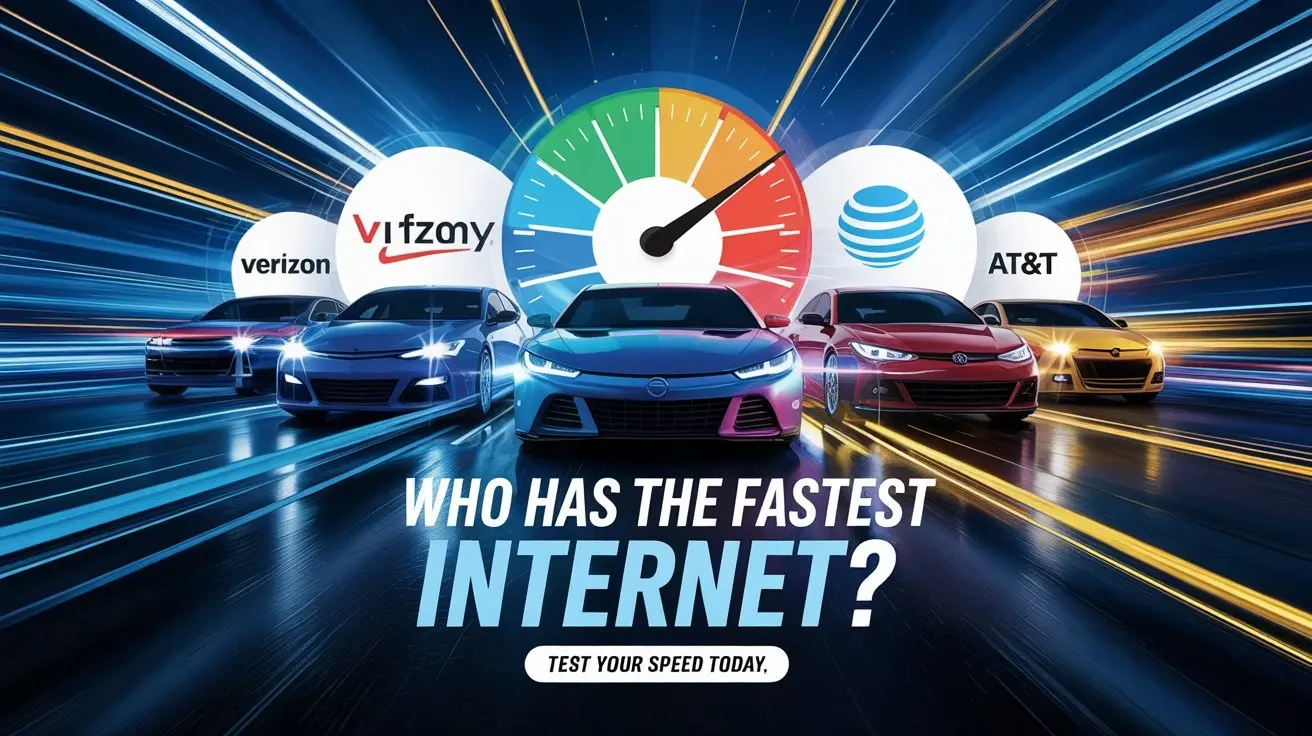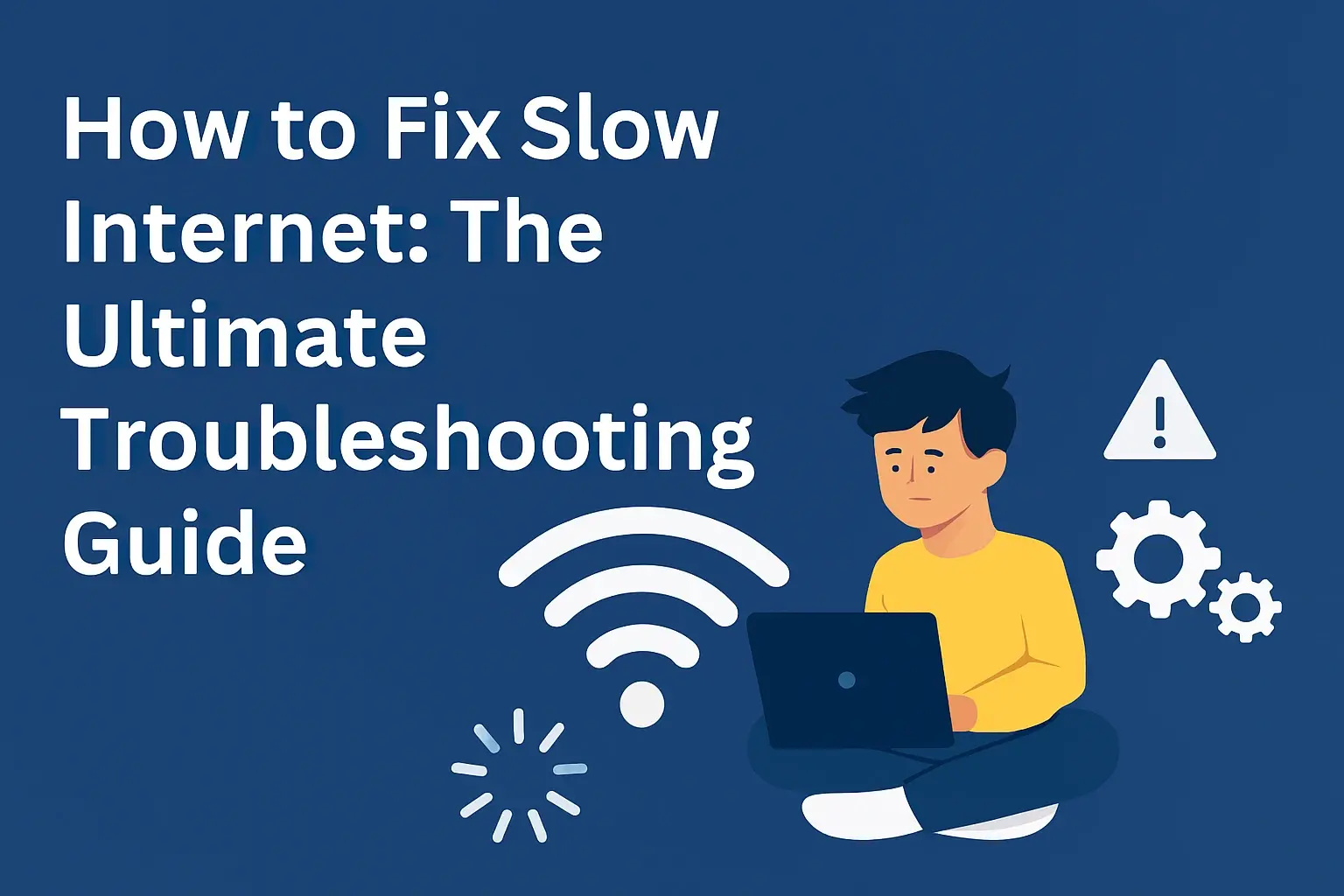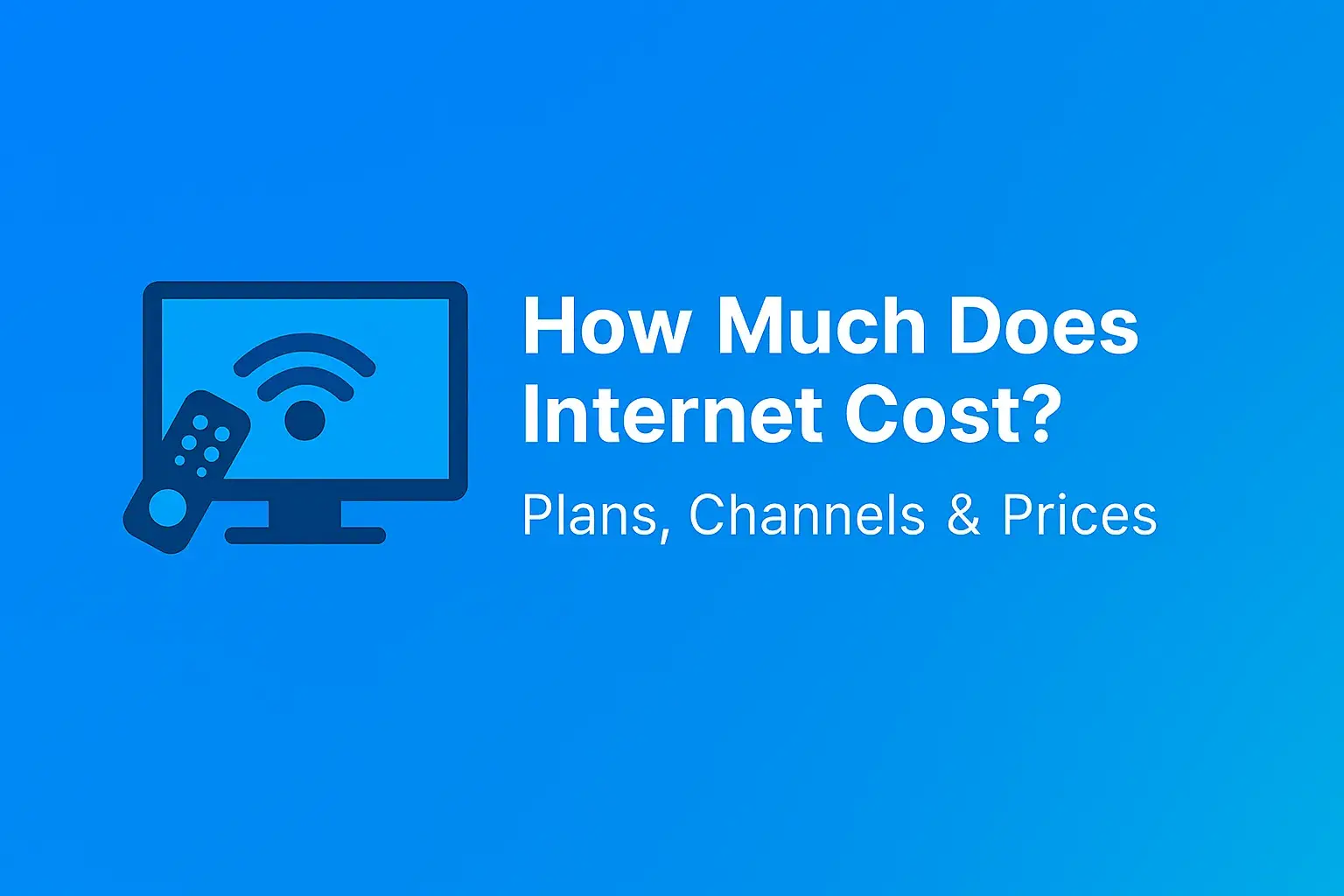Who Has the Fastest Internet ?

Unlocking the answer to "Who has the fastest internet?" involves navigating a complex landscape of providers, technologies, and geographical limitations. This guide dives deep into 2025's fastest internet options, helping you identify the leading contenders and understand what truly defines speed.
Understanding Internet Speed Metrics
Before we can crown any provider as the fastest, it's crucial to understand what "fast" actually means in the context of internet connectivity. The terms often thrown around – Mbps, Gbps, latency, ping – can be confusing. Let's break them down to ensure we're all on the same page when discussing internet speeds in 2025.
Download Speed (Mbps/Gbps)
This is what most people think of when they hear "internet speed." Download speed refers to the rate at which data can be transferred from the internet to your device. It's measured in megabits per second (Mbps) or gigabits per second (Gbps). A higher Mbps or Gbps number means faster downloads. For example, downloading a large file like a movie or a software update will be significantly quicker with higher download speeds. In 2025, we're seeing many providers offering speeds in the gigabit range, which is a massive leap from the megabit speeds that were standard just a few years ago. This is essential for activities like streaming 4K video, online gaming, and large file transfers.
Upload Speed (Mbps/Gbps)
While download speed is about receiving data, upload speed is about sending data from your device to the internet. This is critical for tasks like video conferencing, uploading large files to cloud storage, live streaming, and online gaming where your actions need to be sent to the server quickly. Historically, upload speeds have been significantly lower than download speeds, especially with technologies like DSL. However, with the rise of fiber optics, upload speeds are becoming much more competitive, often matching download speeds in symmetrical fiber plans. This is a key differentiator for providers aiming to offer the "fastest" and most versatile internet experience.
Latency (Ping)
Latency, often referred to as ping, measures the time it takes for a small packet of data to travel from your device to a server on the internet and back. It's measured in milliseconds (ms). Lower latency is better. High latency means a delay between when you perform an action (like clicking a link or moving your character in a game) and when the response is registered. For real-time applications like online gaming, video conferencing, and even fast-paced web browsing, low latency is as important as high bandwidth. A provider might offer extremely high download and upload speeds, but if the latency is poor, the experience can still feel sluggish and unresponsive.
Jitter
Jitter is the variation in latency over time. While low latency is good, consistent latency is also crucial for smooth performance, especially in real-time applications. High jitter can cause choppy audio and video during calls, lag spikes in games, and general unreliability. It's a measure of how stable the connection is, and providers that minimize jitter are often considered superior for demanding applications.
Bandwidth vs. Speed
It's also important to distinguish between bandwidth and speed. Bandwidth is the maximum amount of data that can be transmitted over your connection at any given time. Speed is how quickly that data is transmitted. Think of bandwidth as the width of a highway and speed as the speed limit on that highway. A wider highway (more bandwidth) allows more cars (data) to travel simultaneously, but the speed limit (speed) determines how fast each car can go. When we talk about the "fastest internet," we're usually referring to a combination of high bandwidth (download and upload speeds) and low latency.
Top Internet Providers in 2025: The Speed Kings
Identifying the absolute "fastest" internet provider is a dynamic question, as speeds vary greatly by location and the specific technology deployed. However, based on 2025 data and industry trends, certain providers consistently lead the pack in offering the highest potential speeds. These are typically companies investing heavily in fiber-optic infrastructure.
Fiber Optic Giants
Fiber optic internet is the undisputed champion when it comes to raw speed and low latency. It uses light signals to transmit data through glass or plastic threads, offering speeds that are orders of magnitude faster than traditional cable or DSL. In 2025, the providers leading the charge in fiber deployment and offering the highest speeds include:
- Google Fiber: Known for its symmetrical gigabit speeds (1 Gbps download and 1 Gbps upload) and competitive pricing in the areas it serves. Google Fiber continues to expand its footprint, offering a premium fiber experience.
- Verizon Fios: A major player in the Northeast and mid-Atlantic regions, Verizon Fios offers multi-gigabit symmetrical speeds (up to 2 Gbps download and 2 Gbps upload) to many residential customers. Their network is entirely fiber-based, ensuring excellent performance.
- AT&T Fiber: AT&T has been aggressively expanding its fiber network across the U.S. They offer plans with speeds up to 5 Gbps download and 5 Gbps upload in select areas, making them a top contender for the fastest residential internet.
- CenturyLink (Quantum Fiber): While historically known for DSL, CenturyLink has rebranded its fiber services as Quantum Fiber and is actively upgrading its network to deliver multi-gigabit speeds in many markets.
- Ziply Fiber: A rapidly growing regional provider focusing on fiber-to-the-home (FTTH) in the Pacific Northwest and other areas. They offer symmetrical gigabit and multi-gigabit speeds.
These providers are pushing the boundaries of what's possible for home internet, making multi-gigabit speeds a reality for an increasing number of consumers. Their commitment to fiber infrastructure is what allows them to offer the truly fastest internet connections available today.
Cable Internet Competitors
While fiber is king, cable internet providers have also made significant strides in increasing their speeds, largely through the DOCSIS 3.1 and emerging DOCSIS 4.0 standards. These technologies allow cable networks to deliver very high download speeds, often reaching gigabit tiers. However, upload speeds on cable networks are typically asymmetrical, meaning they are much lower than download speeds.
- Xfinity (Comcast): As the largest cable provider in the U.S., Xfinity offers gigabit download speeds in many areas. Their top-tier plans can reach up to 2 Gbps download, though upload speeds are usually a fraction of that. They are also testing and rolling out DOCSIS 4.0, which promises higher upload speeds.
- Spectrum (Charter Communications): Spectrum also provides gigabit download speeds in its service areas. Similar to Xfinity, their upload speeds are generally lower than their download capabilities.
For users whose primary need is extremely fast downloads and who don't heavily rely on high-speed uploads, these cable providers can offer a very compelling and fast internet experience. However, for symmetrical performance and the lowest latency, fiber remains the superior choice.
Fixed Wireless and 5G Home Internet
In areas where traditional wired infrastructure is limited, fixed wireless and 5G home internet services are emerging as viable alternatives, offering surprisingly competitive speeds. These services use cellular technology to deliver internet to a fixed location.
- Verizon 5G Home Internet: Offers speeds that can rival some cable plans, with potential download speeds ranging from 100 Mbps to over 1 Gbps depending on the specific 5G signal strength and network congestion. Latency is generally lower than traditional wireless but higher than fiber.
- T-Mobile 5G Home Internet: Similar to Verizon, T-Mobile leverages its extensive 5G network to provide home internet. Speeds can vary but often fall in the 75-300 Mbps range, with potential for higher speeds in optimal conditions.
- Starlink (SpaceX): While not strictly "fastest" in terms of raw Gbps, Starlink offers impressive speeds and low latency for satellite internet, especially in rural and underserved areas. Download speeds typically range from 50-200 Mbps, with latency significantly lower than traditional geostationary satellites. It's a game-changer for those with no other high-speed options.
These technologies are crucial for bridging the digital divide, but they are unlikely to be the absolute "fastest" in densely populated areas where fiber is available. Their strength lies in accessibility and providing a significant upgrade over older DSL or satellite services.
2025 Speed Comparison: Top Contenders
To give you a clearer picture, here's a comparative look at the typical maximum speeds offered by leading providers in 2025. Remember, actual speeds can vary significantly based on your exact location and the specific plan you choose.
| Provider | Technology | Max Download Speed (Gbps) | Max Upload Speed (Gbps) | Typical Latency (ms) | Availability Focus |
|---|---|---|---|---|---|
| Google Fiber | Fiber Optic | 1 | 1 | 10-20 | Select Cities |
| Verizon Fios | Fiber Optic | 2 | 2 | 10-20 | Northeast/Mid-Atlantic |
| AT&T Fiber | Fiber Optic | 5 | 5 | 10-20 | Nationwide Expansion |
| Quantum Fiber (CenturyLink) | Fiber Optic | 1-2 | 1-2 | 10-25 | Various Markets |
| Ziply Fiber | Fiber Optic | 1-2 | 1-2 | 10-20 | Pacific Northwest & Others |
| Xfinity (Comcast) | Cable (DOCSIS 3.1/4.0) | 2 | 0.1-0.2 | 15-30 | Nationwide |
| Spectrum | Cable (DOCSIS 3.1) | 1 | 0.05-0.1 | 15-30 | Nationwide |
| Verizon 5G Home Internet | 5G Fixed Wireless | Up to 1 | Varies (lower than download) | 20-50 | Select Cities |
| T-Mobile 5G Home Internet | 5G Fixed Wireless | 0.3 (avg) | Varies (lower than download) | 25-60 | Select Cities |
| Starlink | Satellite | 0.2 (avg) | 0.02 (avg) | 25-60 | Global (Rural Focus) |
Technologies Driving Unprecedented Speeds
The quest for faster internet is powered by continuous innovation in networking technologies. Understanding these advancements helps explain why certain providers can offer such incredible speeds and what we can expect in the future.
Fiber Optics: The Current Champion
As mentioned, fiber optic technology is the backbone of the fastest internet connections available today. It utilizes thin strands of glass or plastic to transmit data as pulses of light. This method offers several key advantages:
- Immense Bandwidth: Light signals can carry vast amounts of data, allowing for symmetrical multi-gigabit speeds that are impossible with copper-based technologies.
- Low Latency: Light travels incredibly fast, and fiber optic cables are less susceptible to interference, resulting in very low and consistent latency.
- Future-Proofing: The infrastructure is designed to handle increasing data demands for decades to come. Upgrading speeds often involves upgrading the equipment at either end of the fiber, not replacing the cable itself.
The primary challenge for fiber is the cost and complexity of deployment, particularly the "last mile" connection to individual homes. This is why fiber availability is still concentrated in urban and suburban areas, though expansion is rapid.
DOCSIS 4.0: Cable's Next Evolution
For cable internet providers, the Data Over Cable Service Interface Specification (DOCSIS) standard is crucial. DOCSIS 3.1 has enabled gigabit download speeds. DOCSIS 4.0, which is beginning to be rolled out in 2025, represents a significant upgrade:
- Higher Speeds: DOCSIS 4.0 aims to deliver symmetrical multi-gigabit speeds (up to 10 Gbps download and 10 Gbps upload in some configurations) over existing coaxial cable infrastructure.
- Improved Efficiency: It offers better spectrum utilization, allowing cable companies to offer faster speeds without requiring a complete network overhaul.
- Reduced Latency: While still generally higher than fiber, DOCSIS 4.0 is expected to offer some improvements in latency compared to previous DOCSIS versions.
This technology allows cable companies to remain competitive in the speed race, especially for download-heavy users, and potentially offer more balanced upload speeds.
5G Fixed Wireless Access (FWA)
The rollout of 5G cellular technology has opened up new possibilities for home internet. 5G FWA uses high-frequency radio waves to connect homes to the cellular network:
- Wider Availability: 5G FWA can be deployed much faster and more affordably than laying fiber, making it an attractive option for areas where wired broadband is scarce.
- Competitive Speeds: In areas with strong 5G signals (especially mmWave, though this has limited range), speeds can rival or exceed those of many cable and DSL connections.
- Moderate Latency: Latency is generally better than older wireless technologies but still typically higher than fiber.
5G FWA is a crucial technology for expanding broadband access, but its ultimate speed and reliability can be affected by signal strength, distance from the tower, and network congestion.
Satellite Internet Advancements (LEO)
Traditional satellite internet (geostationary satellites) has always been plagued by high latency and moderate speeds. However, the advent of Low Earth Orbit (LEO) satellite constellations, like SpaceX's Starlink, has revolutionized this space:
- Lower Latency: LEO satellites orbit much closer to Earth, drastically reducing latency to levels comparable to some terrestrial broadband.
- Improved Speeds: While not yet matching fiber, LEO satellite internet offers download speeds that are a significant upgrade over older satellite options, making activities like HD streaming and video conferencing feasible.
- Global Reach: This technology is vital for connecting remote and rural areas that are economically unfeasible to serve with wired infrastructure.
Starlink and similar LEO services are a lifeline for many, providing high-speed internet where it was previously unavailable, though they may not be the absolute fastest option in urban environments.
Factors Influencing Your Actual Internet Speed
Even if you subscribe to the "fastest" internet plan available, your actual experience can be affected by a multitude of factors. Understanding these can help you troubleshoot slowdowns and optimize your connection.
Your Internet Plan's Advertised Speeds
The advertised speeds are typically the maximum theoretical speeds your provider can deliver to your modem under ideal conditions. They are often "up to" speeds, meaning you might not consistently achieve them. Providers also usually specify whether speeds are symmetrical (download = upload) or asymmetrical.
Your Equipment: Modem and Router
Your modem and router are critical bottlenecks. An outdated modem might not support the full speeds of your plan, especially if you're on a gigabit plan. Similarly, a low-quality or older router can struggle to distribute high speeds throughout your home, particularly over Wi-Fi.
- Modem Compatibility: Ensure your modem is rated for the speeds you're paying for. For cable internet, check DOCSIS compatibility (e.g., DOCSIS 3.0 vs. DOCSIS 3.1). For fiber, the Optical Network Terminal (ONT) is provided by the ISP.
- Router Performance: A modern Wi-Fi router (Wi-Fi 6 or Wi-Fi 6E) is essential for maximizing wireless speeds. Look for routers with good processing power and beamforming technology. Consider a mesh Wi-Fi system for larger homes to ensure consistent coverage.
Wi-Fi vs. Wired Connection
The difference between a wired Ethernet connection and Wi-Fi can be substantial. Wi-Fi is convenient but inherently less stable and slower than a direct Ethernet connection due to signal interference, distance from the router, and the number of devices connected.
- Ethernet: Always provides the most reliable and fastest connection to your device. If you need maximum speed for a stationary device (like a desktop PC or gaming console), use an Ethernet cable.
- Wi-Fi: Performance degrades with distance and obstructions. For the best Wi-Fi experience, place your router in a central location, minimize interference from other electronics, and ensure your devices support the latest Wi-Fi standards.
Network Congestion
This is a significant factor, especially for cable and fixed wireless internet. When many users in your neighborhood are online simultaneously, especially during peak hours (evenings and weekends), the shared bandwidth can become congested, leading to slower speeds for everyone.
- Cable Networks: Share bandwidth with your neighbors. High usage in your area can impact your speeds.
- Fiber Networks: Generally less prone to congestion as each connection is more dedicated, but overselling can still occur in rare cases.
- 5G/Fixed Wireless: Can experience congestion if many users are connected to the same cell tower.
Number of Connected Devices
Every device connected to your network consumes bandwidth. If you have numerous devices streaming, gaming, downloading, or browsing simultaneously, your available bandwidth will be split among them, potentially slowing down individual devices.
Your Device's Capabilities
The device you're using (computer, smartphone, tablet) also plays a role. An older device with a slower processor or older network card might not be able to process data as quickly as your internet connection can deliver it.
Time of Day
As mentioned under network congestion, speeds can often be slower during peak usage hours. Testing your internet speed at different times of the day can reveal these variations.
Distance from Provider's Equipment (for DSL/Fixed Wireless)
For DSL, the further you are from the telephone company's central office (or node), the slower your speeds will be. For fixed wireless, distance and obstructions between your home and the provider's tower are critical.
How to Find the Fastest Internet for Your Needs
Identifying the "fastest" internet provider isn't just about looking at the highest advertised speeds. It's about finding the best combination of speed, reliability, and affordability that meets your specific needs and is available in your location.
Step 1: Determine Your Location's Availability
This is the most critical first step. The fastest internet technology and providers are useless if they aren't available at your address. Use online tools from major providers (Verizon, AT&T, Xfinity, Google Fiber, etc.) and third-party comparison sites to check availability in your area.
- Enter your full address on provider websites.
- Utilize broadband comparison websites that aggregate availability data.
Step 2: Assess Your Internet Usage Needs
Be realistic about how you use the internet. This will help you determine the required speeds and latency.
- Basic Browsing & Email: 25-50 Mbps download is usually sufficient.
- Streaming HD Video (1-2 devices): 50-100 Mbps download.
- Streaming 4K Video (multiple devices), Online Gaming: 100-300 Mbps download. Low latency is crucial here.
- Heavy Online Gaming, Live Streaming, Large File Uploads/Downloads, Multiple 4K Streams: 300 Mbps to 1 Gbps+ download and symmetrical upload speeds are ideal. Low latency is paramount.
- Smart Home Devices, IoT: While they don't consume much bandwidth individually, a large number can benefit from higher overall capacity.
Step 3: Compare Technologies and Providers
Once you know what's available and what you need, compare the options:
- Fiber Optic: If available, this is almost always the best choice for raw speed, symmetrical uploads, and low latency. Look at providers like AT&T Fiber, Verizon Fios, Google Fiber, or regional fiber providers.
- Cable: A good option if fiber isn't available. Offers high download speeds, but upload speeds are limited. Xfinity and Spectrum are major players.
- 5G Home Internet: A viable alternative in areas lacking wired options. Speeds can be good, but consistency may vary.
- DSL: Generally the slowest option, only consider if no other broadband is available.
- Satellite: LEO satellite (like Starlink) is a good option for remote areas, but traditional satellite is very slow and has high latency.
Step 4: Analyze Speed Test Data and Reviews
Advertised speeds are one thing; real-world performance is another. Look for independent speed test data and customer reviews for your specific area.
- Speed Test Websites: Sites like Ookla's Speedtest.net or Fast.com allow users to test their speeds and contribute to a database. Look for aggregated data for your region.
- Customer Reviews: Check local forums, consumer review sites, and even social media for feedback on provider reliability, customer service, and actual speeds experienced by users in your neighborhood.
Step 5: Consider Latency and Jitter
For gamers, streamers, and those who rely on real-time communication, latency and jitter are as important as download/upload speeds. Fiber optic connections typically offer the lowest and most consistent latency.
Step 6: Evaluate Pricing and Contracts
The fastest internet isn't always the most expensive, but it often comes at a premium. Compare the monthly costs, any installation fees, equipment rental fees, and contract lengths. Watch out for promotional pricing that expires after a year.
Step 7: Look for Symmetrical Speeds
If you frequently upload large files, use cloud storage extensively, or stream live content, symmetrical speeds (where upload speed matches download speed) are a significant advantage. Fiber optic plans are the most likely to offer this.
Example Scenario: A gamer living in a city with AT&T Fiber and Xfinity available might choose AT&T Fiber for its 1 Gbps symmetrical speeds and low latency, even if Xfinity offers a 1.2 Gbps download plan, because the symmetrical upload and lower latency are critical for their gaming experience. Conversely, a user who primarily streams 4K movies and downloads large files but rarely uploads might find Xfinity's 1.2 Gbps download plan to be a better value if it's significantly cheaper than fiber.
The Future of Internet Speed: What's Next?
The relentless pursuit of faster internet shows no signs of slowing down. As data consumption continues to explode, driven by technologies like AI, VR/AR, and the metaverse, the demand for ever-increasing speeds and lower latency will only grow. Here's a glimpse into what the future holds for internet speeds:
Beyond 10 Gbps Fiber
While 1 Gbps and even 2-5 Gbps are becoming common for residential users, the fiber optic industry is already looking towards 10 Gbps and beyond. Technologies like 25G PON (Passive Optical Network) and 50G PON are in development and testing. These advancements will allow fiber networks to deliver multi-gigabit symmetrical speeds to millions more homes, supporting the most demanding applications imaginable.
Advancements in DOCSIS
DOCSIS 4.0 is the current frontier for cable, promising symmetrical multi-gigabit speeds. Future iterations could push these speeds even higher, allowing cable providers to remain competitive. The challenge will be upgrading the existing coaxial infrastructure to support these extreme speeds reliably.
The Evolution of 5G and Beyond (6G)
5G FWA is just the beginning. As 5G networks mature and become denser, speeds and reliability will improve. Looking further ahead, 6G technology is already being researched. 6G promises speeds that are orders of magnitude faster than 5G, with near-zero latency, potentially blurring the lines between wired and wireless connectivity and enabling truly immersive holographic communication and advanced AI integration.
Satellite Constellations and Global Connectivity
LEO satellite internet is rapidly expanding, bringing high-speed broadband to previously unreachable areas. Future generations of satellites will likely offer even higher speeds and lower latency, further shrinking the digital divide and providing robust connectivity options globally.
Edge Computing and Reduced Latency
The development of edge computing, where data processing happens closer to the user rather than in distant data centers, will play a crucial role in perceived speed and responsiveness. By reducing the physical distance data needs to travel, edge computing can significantly lower latency, making real-time applications feel instantaneous, even if the raw bandwidth isn't astronomically high.
AI-Driven Network Optimization
Artificial intelligence will be increasingly used to manage and optimize internet networks. AI algorithms can predict traffic patterns, reroute data to avoid congestion, dynamically allocate bandwidth, and proactively identify and resolve network issues, leading to more stable and consistently fast connections for users.
The race for the fastest internet is not just about raw speed; it's about delivering a seamless, responsive, and reliable digital experience. As these technologies mature and converge, we can expect a future where high-speed internet is more accessible, more powerful, and more integrated into our daily lives than ever before.
In conclusion, the question of "Who has the fastest internet?" in 2025 is definitively answered by fiber optic providers like AT&T Fiber, Verizon Fios, and Google Fiber, who offer symmetrical multi-gigabit speeds and ultra-low latency. While cable providers are catching up with DOCSIS 4.0 and 5G home internet offers a viable alternative in many areas, fiber remains the gold standard for pure speed and performance. To find the fastest internet for *you*, prioritize checking local availability, assessing your actual usage needs, and comparing not just download speeds but also upload speeds and latency. The future promises even greater speeds and lower latency, driven by continuous innovation in fiber, wireless, and satellite technologies, making the digital world more connected and responsive than ever before.**
Faq
1. Who currently offers the fastest internet speed in the U.S.?
As of 2025, Google Fiber and Xfinity offer speeds up to 2 Gbps in select areas.
2. Is fiber internet faster than cable or DSL?
Yes, fiber is the fastest and most reliable type of internet with symmetrical upload/download speeds.
3. Does location affect internet speed?
Yes, your speed depends on provider availability and local infrastructure in your area.
4. How can I check the fastest internet in my zip code?
Use an internet availability tool to compare top speeds from ISPs in your zip code.
5. Can I improve my internet speed at home?
Yes, upgrade your plan, router, or switch to a faster provider like fiber or cable.





